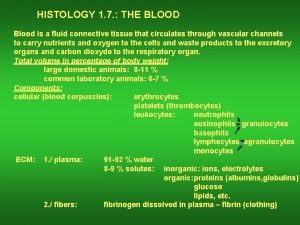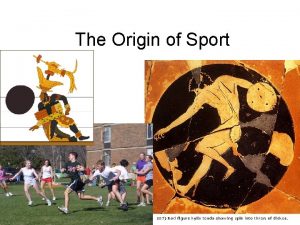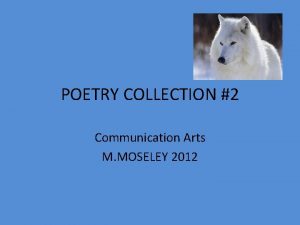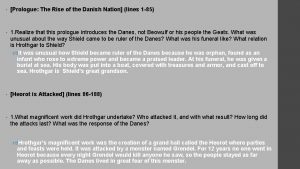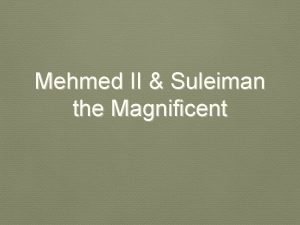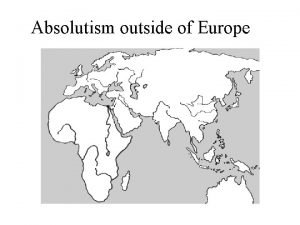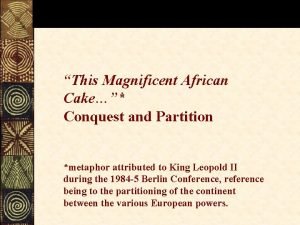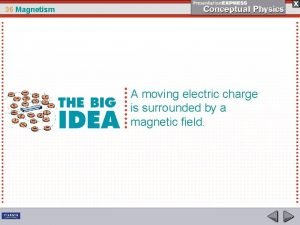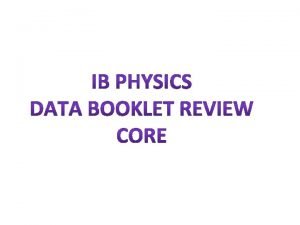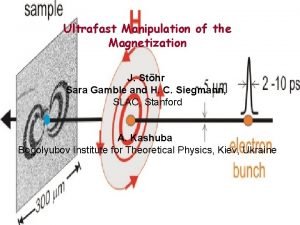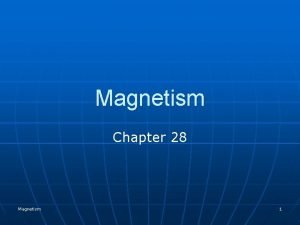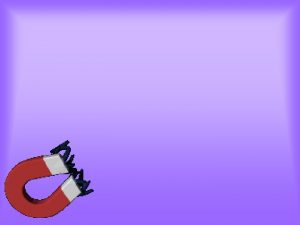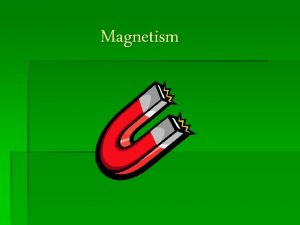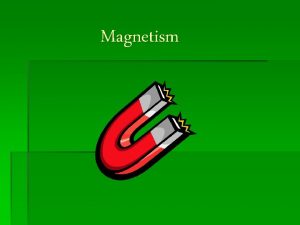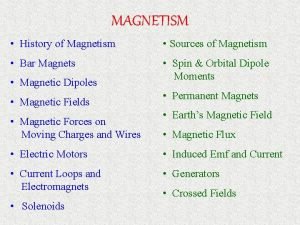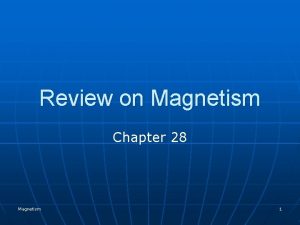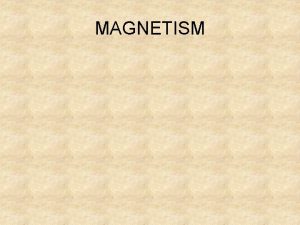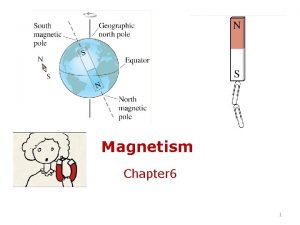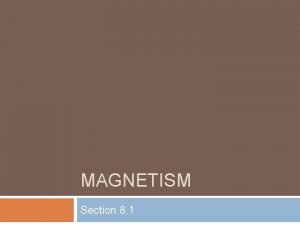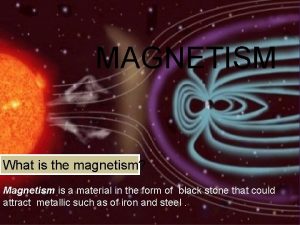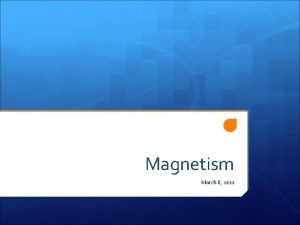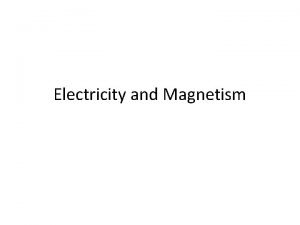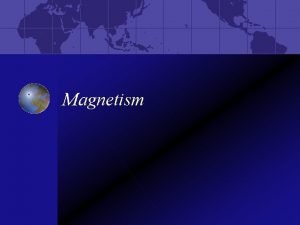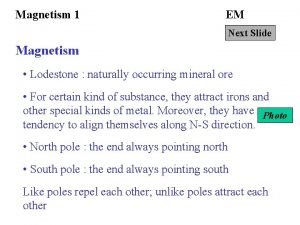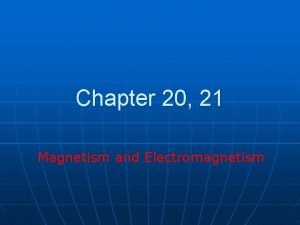CH 22 Magnetism The magnificent spectacle of the
























- Slides: 24

CH 22: Magnetism The magnificent spectacle of the Aurora Borealis, or northern lights, glows in the northern sky above Bear Lake near Eielson Air Force Base, Alaska. Shaped by the Earth’s magnetic field, this light is produced by radiation spewed from solar storms. (credit: Senior Airman Joshua Strang, via Flickr)

Outline • Magnets, Magnetic fields, and Magnetic field of the Earth • Force on a moving charge in a magnetic field • Motion of a charge particle in a magnetic field • The mass spectrometer • Force on a current in a magnetic field • Magnetic fields produced by currents • Magnetic Resonance Imaging (MRI) • Cathode Ray Tube (CRT) • Magnetic storage

Magnetic Compass The needle of a compass is a permanent magnet that has a north magnetic pole (N) at one end a south magnetic pole (S) at the other. Navigation in animals: Vertebrates (ex: migratory birds) and invertebrates (ex: Spiny lobsters) use the earth's magnetic field to navigate and determine their geographic position. Cow’s magnet and feeding.

Magnetic Poles Like poles repel each other, and unlike poles attract each other.

North and south poles always occur in pairs. Attempts to separate them result in more pairs of poles. If we continue to split the magnet, we will eventually get down to an iron atom with a north pole and a south pole— these, too, cannot be separated. https: //phys. org/news/2016 -08 mysterious-magnetic-monopole. html

Magnetic Field of Magnets

Magnetic Field of the Earth The earth behaves magnetically almost as if a bar magnet were located near its center. The axis of this fictitious bar magnet does not coincide with the earth's rotational axis; the two axes are currently about 11. 5° apart.

Angle of Declination The south magnetic pole does not coincide with the north geographic pole but, its position is not fixed but moves over the years. The angular difference between the magnetic north and the geographical north is called the angle of declination.

Angle of Dip Earth's magnetic field lines are not parallel to the surface at all points. For instance, near the north magnetic pole the field lines are almost perpendicular to the surface of the earth. The angle that the magnetic field makes with respect to the surface at any point is known as the angle of dip.

The Force That a Magnetic Field Exerts on a Moving Charge The following two conditions must be met for a charge to experience a magnetic force when placed in a magnetic field: 1. The charge must be moving. No magnetic force acts on a stationary charge. 2. The velocity of the moving charge must have a component that is perpendicular to the direction of the magnetic field.

Magnetic Force Consider a charge q 0, moving with velocity v, in a magnetic field. Magnetic field will be denoted by the symbol B. The magnetic force is given by, where θ is the angle between the magnetic field and velocity. 10. An electron moving at 4. 00× 103 m/s in a 1. 25 -T magnetic field experiences a magnetic force of 1. 40× 10− 16 N. What angle does the velocity of the electron make with the magnetic field?

Right-hand Rule No. 1 When the right hand is oriented so the fingers point along the magnetic field B and the thumb points along the velocity v of a positively charged particle, the palm faces in the direction of the magnetic force F applied to the particle.

Application of RHR 1. What is the direction of the magnetic force on a positive charge that moves as shown in each of the six cases shown below?

Definition of the Magnetic Field Magnetic field is the force on a unit charge moving with a unit velocity perpendicular to the magnetic field. The SI unit of the magnetic field is the tesla, T named after the Croatian-born American engineer Nikola Tesla (1856 -1943).

Units of Magnetic Field The cgs unit for the magnetic field is the gauss, G. 1 T = 104 G. The Earth’s magnetic field near its surface is about 0. 5 G or 5 10 -5 T. Laboratory electromagnets can produce magnetic fields as high as 3 T. Superconducting magnets can produce magnetic fields up to 30 T. https: //www. youtube. com/watch? v=jjc. HZu. TGWXk

The Motion of a Charged Particle in an Electric or Magnetic Field

Velocity Selector 17. A velocity selector in a mass spectrometer uses a 0. 100 -T magnetic field. (a) What electric field strength is needed to select a speed of 4. 00× 106 m/s ? (b) What is the voltage between the plates if they are separated by 1. 00 cm?

The Circular Motion

Mass Spectrometer Physicists use mass spectrometers for determining the relative masses and abundances of isotopes. Chemists use these instruments to help identify unknown molecules produced in chemical reactions. Mass spectrometers are also used during surgery, where they give the anesthesiologist information on the gases, including the anesthetic, in the patient's lungs.

Problem 20 20. A mass spectrometer is being used to separate common oxygen-16 from the much rarer oxygen-18, taken from a sample of old glacial ice. (The relative abundance of these oxygen isotopes is related to climatic temperature at the time the ice was deposited. ) The ratio of the masses of these two ions is 16 to 18, the mass of oxygen-16 is 2. 66× 10− 26 kg, and they are singly charged and travel at 5. 00× 106 m/s in a 1. 20 -T magnetic field. What is the separation between their paths when they hit a target after traversing a semicircle?

The Force on a Current in a Magnetic Field https: //www. youtube. com/watch? v =t. UCt. CYty-ns

Loudspeaker

The Torque on a Current. Carrying Coil

Electric Motor
 Latin roots spec
Latin roots spec Minute colorless anucleate corpuscles found in the blood
Minute colorless anucleate corpuscles found in the blood Victor hugo spectacle rassurant
Victor hugo spectacle rassurant We are a spectacle to the world
We are a spectacle to the world The b ocean
The b ocean Play spectacle
Play spectacle Suleiman the magnificent empire map
Suleiman the magnificent empire map Yemen architecture
Yemen architecture Sleeky flatterer meaning
Sleeky flatterer meaning Hemo the magnificent
Hemo the magnificent What magnificent work does hrothgar undertake
What magnificent work does hrothgar undertake Mehmed the magnificent
Mehmed the magnificent Suleiman the magnificent absolutism
Suleiman the magnificent absolutism The magnificent bull poem
The magnificent bull poem Magnificent african cake
Magnificent african cake Chapter 36 magnetism answer key
Chapter 36 magnetism answer key Electromagnet experiment hypothesis
Electromagnet experiment hypothesis Electricity and magnetism
Electricity and magnetism Conceptual physics magnetism
Conceptual physics magnetism Ultrafast magnetism
Ultrafast magnetism Maxwell equation for time varying field
Maxwell equation for time varying field Magnetism
Magnetism Magnetism is an invisible
Magnetism is an invisible Physics 102 electricity and magnetism
Physics 102 electricity and magnetism Magnetism and electromagnetism gcse
Magnetism and electromagnetism gcse

